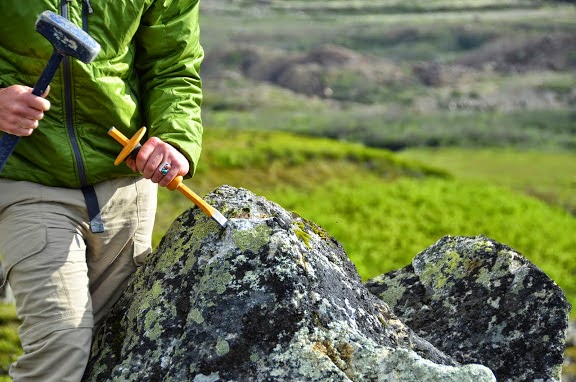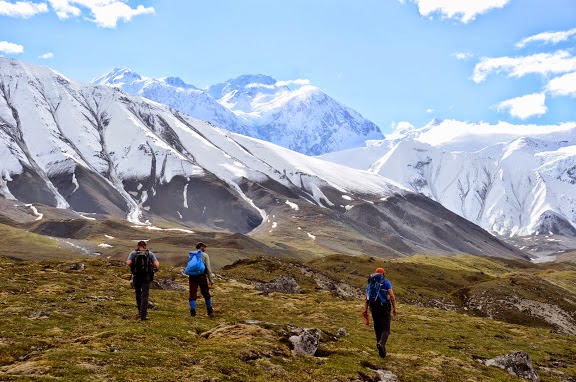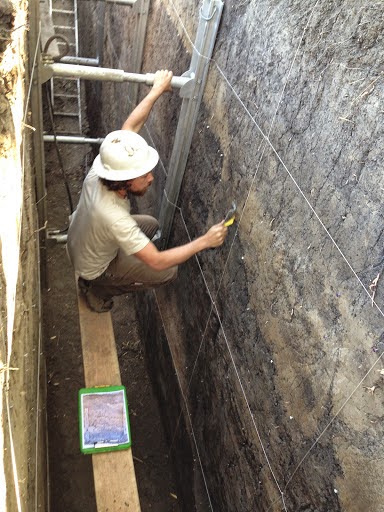
Sean Bemis put his hands together side by side to demonstrate two plates of the earth’s crust with a smooth boundary running between them. But that boundary is not always smooth and those plates do not always sit together neatly, which makes the earth’s crust a dynamic and complex surface.
As a structural geologist and paleoseismologist, Bemis often uses visual and three dimensional (3-D) models to explain his studies of the earth’s crust; sometimes that entails sophisticated 3-D digital imagery, maps and diagrams of fault lines, the rocks he processes in his lab, or, as in this case, his own hands.
These techniques not only help Bemis demonstrate his research, they also represent the multidimensional nature of his work.
Bemis, an assistant professor in UK’s Department of Earth and Environmental Sciences, studies the deformation of the tectonic plates that make up Earth’s crust. When these plates move, they slide past each other, with most of the motion occurring across relatively narrow zones.
Due to the large amount of crushing required for the Earth’s crust to move, the zones between plates, called plate boundaries, are sites of frequent, often damaging earthquakes and the formation of dramatic mountain ranges. Some of these plate boundaries are also very well-known faults, such as the San Andreas fault in California.
Bemis simplifies some key terminology when he says, “A fault is just a break in rock; an active fault is one that has moved recently and has the potential to move again in the near future.” In particular, he researches the San Andreas fault in California and the Denali fault in Alaska.

By excavating faults in California and Alaska, Bemis and his team identify plate deformation recorded as prehistoric earthquakes. With the rocks, soil and organic matter they examine, they can use radiocarbon dating to identify when an earthquake occurred.
With these findings, Bemis can determine the character of a fault, which helps scientists forecast the likelihood and size of possible future earthquakes. “Understanding how earthquakes recur through time,” Bemis explained, “can tell us how the surface of the Earth is evolving in terms of the deformation as well as community-related hazards and hazard mitigation needs.”
While in graduate school at the University of Alaska Fairbanks, Bemis did field work in Denali. He even discovered and named several previously unknown active faults in the region. In 2002, there was a major earthquake on the Denali fault—the largest in the world that year. At the time it occurred, Bemis recalled, “I was a hundred miles away from the earthquake, but I could barely stand up, that’s how strong it was.”
Bemis likens the earthquake process (in its simplest form) to breaking a rubber band that you stretch, building up pressure until it snaps. But with an earthquake, the pressure builds in miles of crust moving at rates of kilometer per second. “That’s a lot of energy,” he remarked. “The spot where I’m standing could jump instantaneously to other side of the room.”

Later, Bemis went out to the fault and could see the effects of the earthquake on the earth’s surface. “The earthquake had sheared the ground surface for hundreds of kilometers and this shearing had opened up large fissures that rotated during the rapid deformation,” Bemis remembered.
These fissures, or openings in the earth’s surface, were so big, Bemis remembered, that he could stand in them and hold his arms up over head and still be below the ground surface. He also saw trees with huge chunks of roots torn off and slipped several meters away.
Over time, the fissures and shearing Bemis observed in Denali would fill in with soil, rocks and organic material, so the surface would eventually come to look like it had before the earthquake. “These observations of recent earthquakes,” like the 2002 Denali earthquake, “help us understand what we need to look for to find evidence for prehistoric earthquakes.” To see buried records of earthquakes, “we go play in the dirt,” Bemis said, laughing.
Even though Bemis has a renovated lab in the Slone Research Building, one might say that his primary lab is in the field, playing in the dirt, so to speak. He and his team excavate a fault, exposing a flat plane or wall in the earth. They can see evidence of earthquakes and deformation in the dirt wall where the color or layers of sediment are inconsistent.
Images of these excavations are helpful for showing what Bemis looks for in his analysis of the earth’s surface.
“You have to be able to visualize that what you’re seeing isn’t actually a 2-D plane, it’s actually something that extends back into space. It’s hard to teach this part,” said Bemis. It’s especially hard in a region like Kentucky where students can’t go out to a nearby active fault like Bemis did at the University of Alaska Fairbanks and at the University of Oregon.
Bemis’s undergraduate and graduate students at UK, however, sometimes have the opportunity to travel to California or Alaska with their professor to excavate a fault. He tries to help his graduate students develop projects out of facets of his research so they are working toward their own research while contributing to his. Therefore, his mentorship is embedded in his research.
For people who won’t get such a first-hand look at a fault excavation, Bemis makes use of digital, high-resolution 3-D imaging that lets a viewer appreciate the greater scope and depth of plate displacement. He especially likes his students to not only look at a 3-D model but to use the mouse to turn it and truly interact with it themselves.
Even in graduate school, Bemis was exploring new ways of demonstrating his study of plate deformation because “as we’re collecting more and more data about these prehistoric earthquakes, all of the simple models are falling apart—they don’t work because the earth is a complex place—there’s a lot of interacting parts.”
From playing in the dirt, to sample processing in the lab, to presenting his findings, Bemis’s research could also be said to have “a lot of interacting parts,” and he continues to explore the new effective means of representing it. Of course, he can always resort to his own hands.
Note : The above story is based on materials provided by University of Kentucky










